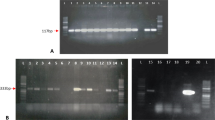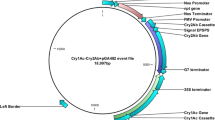Abstract
Insect pests are a major cause of damage to the world's commercially important agricultural crops. Current strategies aimed at reducing crop losses rely primarily on chemical pesticides. Alternatively transgenic crops with intrinsic pest resistance offer a promising alternative and continue to be developed. The first generation of insect-resistant transgenic plants are based on insecticidal proteins from Bacillus thuringiensis (Bt). A second generation of insect-resistant plants under development include both Bt and non-Bt proteins with novel modes of action and different spectra of activity against insect pests.
This is a preview of subscription content, access via your institution
Access options
Subscribe to this journal
Receive 12 print issues and online access
$209.00 per year
only $17.42 per issue
Buy this article
- Purchase on Springer Link
- Instant access to full article PDF
Prices may be subject to local taxes which are calculated during checkout
Similar content being viewed by others
References
Oerke, E.G. 1994. Estimated crop losses due to pathogens, animal pests and weeds, pp. 72–88 in Crop production and crop protection: estimated losses in major food and cash crops. Oerke, E.G., Dehne, H.W., Schonbeck, R, and Weber, A. (eds.). Elsevier, Amsterdam.
Klee, H., Horsch, R. and Rogers, S. 1987. Agrobacterium-mediated plant transformation and its further applications to plant biology. Annu. Rev. Plant Physiol. 38: 467–486.
Potrykus, I. 1991. Gene transfer to plants: Assessment of published approaches and results. Annu. Rev. Plant Physiol. Plant Mol. Biol. 42: 205–225.
Randolph-Anderson, B., Boynton, J.E., Dawson, J., Dunder, E., Eskes, R., Gillham, N.W., Johnson, A., Perlman, P.S., Suttie, J. and Heiser, W.C. 1995. Submicron gold particles are superior to larger particles for efficient biolistic transformation of organelles and some sell types. Bio-Rad US/EG Bulletin 2015.
Koziel, M.G., Beland, G.L., Bowman, C., Carozzi, N.B., Crenshaw, R., Crossland, L., Dawson, J., Desai, N., Hill, M., Kadwell, S., Launis, K., Lewis, K., Maddox, D., McPherson, K., Meghji, M.R., Merlin, E., Rhodes, R., Warren, G.W., Wright, M. and Evola, S.V. 1993. Field performance of elite transgenic maize plants expressing an insecticidal protein derived from Bacillus thuringiensis. Bio/Technology 11: 194–200.
Umbeck, P.F. 1992. Genetic engineering of cotton plants and lines. United States Patent 5, 159, 135.
Koziel, M.G., Carozzi, N.B., Currier, T.C., Warren, G.W. and Evola, S.V. 1993. The insecticidal crystal proteins of Bacillus thuringiensis: past, present and future uses. Biotechnol. and Genet. Engineer. Rev. 11: 171–228.
Koziel, M.G., Carozzi, N.B. and Desai, N. 1997. Optimizing expression of trans-genes with an emphasis on post-transcriptional events. Plant Mol. Biol., in press.
Perlak, F.J., Fuchs, R.L., Dean, D.A., McPherson, S.L., and Fischhoff, D.A. 1991. Modification of the coding sequence enhances plant expression of insect control protein genes. Proc. Natl. Acad. Sci. USA 88: 3324–3328.
Gill, S.S., Cowles, E.A. and Pietrantonio, R.V. 1992. The mode of action of Bacillus thuringiensis endotoxins. Annu. Rev. Entomol. 37: 615–636.
World Wide Web address: www.susx.ac.uk/users/bafn6/bt/index.html
Schnepf, H.E. and Whiteley, H.R. 1981. Cloning and expression of the Bacillus thuringiensis crystal protein gene in Escherichia coli. Proc. Natl. Acad. Sci. USA 78: 2893–2897.
Vaeck, M., Reynaerts, A., Höfte, H., Jansens, S., De Beuckeleer, M., Dean, C., Zabeau, M., van Montagu, M. and Leemans, J. 1987. Transgenic plants protected from insect attack. Nature 327: 33–37.
Fischhoff, D.A., Bowdish, K.S., Perlak, F.J., Marrone, P.G., McCormick, S.M., Niedermaeyer, J.G., Dean, D.A., Kusano-Kretzmer, K., Mayer, E.J., Rochester, D.E., Rogers, S.G. and Fraley, R.T. 1987. Insect tolerant transgenic tomato plants. Bio/Technology 5: 807–813.
Peferoen, M. 1992. Engineering of insect resistant plants with Bacillus thuringiensis crystal protein genes, pp. 135–153 in Biotechnology in agriculture. Gatehouse, A., Hilder, V., and Boulter, D. (eds.). CAB International, Wallingford.
Warren, G.W., Carozzi, N.B., Desai, N., and Koziel, M.G. 1992. Field evaluation of transgenic tobacco containing a Bacillus thuringiensis insecticidal protein gene. J. Econ. Entomol. 5: 1651–1659.
Delannay, X., La Vallee, B.J., Proksch, R.K., Fuchs, R.L., Sims, S.R., Greenplate, J.T., Marrone, P.G., Dodson, R.B., Augustine, J.J., Layton, J.G. and Fischhoff, D.A. 1989. Field performance of transgenic tomato plants expressing the Bacillus thuringiensis var kurstaki insect control protein. Bio/Technology 7: 1265–1269.
Perlak, F.J., Deaton, R.W., Armstrong, T.A., Fuchs, R.L., Sims, S.R., Greenplate, J.T. and Fischhoff, D.A. 1990. Insect resistant cotton plants. Bio/Technology 8: 939–943.
Wilson, F.D., Flint, H.M., Deaton, R.W., Fischhoff, D.A., Perlak, F.J., Armstrong, T.A., Fuchs, R.L., Berberich, S.A., Parks, N.J. and Stapp, B.R. 1992. Resistance of cotton lines containing a Bacillus thuringiensis toxin to pink bollworm (Lepidoptera: Gelechiidae) and other insects. J. Econ. Entomol. 85: 1516–1521.
Perlak, F.J., Stone, T.B., Muskopf, Y.M., Petersen, L.J., Parker, G.B., McPherson, S.A., Wyman, J., Love, S., Reed, G., Biever, D. and Fischhoff, D.A. 1993. Genetically improved potatoes: protection from damage by Colorado potato beetles. Plant Mol. Biol. 22: 313–321.
Adang, M.J., Brody, M.S., Cardineau, G., Eagan, N., Roush, R.T., Shewmaker, C.K., Jones, A., Oakes, J.V. and McBride, K.E. 1993. The reconstruction and expression of a Bacillus thuringiensis crylllA gene in protoplasts and potato plants. Plant Mol. Biol. 21: 1131–1145.
Moberg, W.K. 1990. Understanding and combating agrochemical resistance, pp. 3–16 in Managing Resistance to Agrochemicals. Green, M.B., LeBaron, H.M., and Moberg, W.K. (eds.). ACS Symposium Series, Washington.
Shelton, A.M., Robertson, J.L., Tang, J.D., Perez, C., Eigenbrode, S.D., Preisler, H.K., Wilsey, W.T. and Cooley, R.J. 1993. Resistance of the diamondback moth (Lepidoptera: Plutellidae) to Bacillus thuringiensis subespecies in the field. J. Econo. Entomol. 86: 697–705.
Felton, G., Donato, K., Broadway, R. and Duffey, S. 1992. Impact of oxidized plant phenolics on the nutrional quality of dietary protein to a noctuid herbivore, Spodoptera exigua. J. Insect Physiol. 38: 277–285.
Hilder, V., Gatehouse, A., Sheerman, S., Barker, R. and Boulter, D. 1987. A novel mechanism of insect resistance engineered into tobacco. Nature 330: 160–163.
Huesing, J.E., Shade, R.E., Chrispeels, M.J. and Murdock, L.L. 1991. α-Amylase inhibitor, not phytohemagglutinin, explains the resistance of common bean seeds to cowpea weevil. Plant Physiol. 96: 993–996.
Ryan, C. 1990. Protease inhibitors in plants: genes for improving defenses against insects and pathogens. Ann. Rev. Phytopathol. 28: 425–449.
Johnson, R., Narvaez, J., An, G. and Ryan, C. 1989. Expression of proteinase inhibitors I and II in transgenic tobacco plants: effects on natural defenses against Manduca sexta larvae. Proc. Natl. Acad. Sci. USA 86: 9871–9875.
Jongsma, M.A., Bakker, P.L., Peters, J., Bosch, D. and Stiekema, W.J. 1995. Adaptation of Spodoptera exigua larvae to plant proteinase inhibitors by induction of gut proteinase activity insensitive to inhibition. Proc. Natl. Acad. Sci. USA 92: 8041–8045.
Ding, X. 1995. Manduca chitinase-mediated resistance to tobacco budworm (Heliothis virescens) and tobacco hornworm (Manduca sexta) larvae in transgenic tobacco plants. Ph.D. Dissertation, Kansas State University, Manhattan, pp. 73.
Chapman, R.F. 1985. Structure of the digestive system, pp. 165–205 in Comprehensive insect physilogy, biochemistry and pharmacology. Kerkut, G.A. and Gilbert, L.I. (eds.). Pergamon Press, Oxford.
Chrispeels, M.J. and Raikhel, N.V. 1991. tins, lectin genes and their role in plant defense. The Plant Cell 3: 1–19.
Cavalieri, A., Czapla, T., Howard, J. and Rao, G. 1995. Larvicidal lectins and plant insect resistance based thereof. United States Patent 5: 407–454.
Harper, S.M., Crenshaw, R.W., Mullins, M.A. and Privalle, L.S. 1995. Lectin binding to insect brush border membranes. J. Econ. Entomol. 88: 1197–1202.
Czapla, T. and Lang, B.A. 1990. Effect of plant lectins on the larval development of European corn borer (Lepidoptera: Pyralidae) and southern corn rootworm (Coleoptera: Chrysomelidae). J. Econo. Entomol. 83: 2480–2485.
Maddock, S.E., Hufman, G., Isenhour, D.J., Roth, B.A., Raikhel, N.V., Howard, J.A. and Czapla, T.H. 1991. Expression in maize plants of wheat germ agglutinin, a novel source of insect resistance. 3rd Int. Cong. Plant Mol. Biol., Tucson, Arizona.
Boulter, D. 1993. Insect pest control by copying nature using genetically engineered crops. Phytochemistry 34: 1453–1466.
Shah, D.M., Rommens, C.M. and Beachy, R.N. 1995. Resistance to diseases and insects in transgenic plants: progress and applications to agriculture. Trends Biotechnol. 13: 362–368.
Kanost, M. and Jiang, H. 1996. Proteinase inhibitors in invertebrate immunity, pp. 45–69 in New directions in invertebrate immunology. Soderhall, K., Iwanaga, S., and Vasta, G. (eds.). SOS Publications, New Jersey.
Luckmann, W.H. 1982. Integrating the cropping system for corn insect pest management, pp. 499–519 in Introduction to insect pest management. Metcalf, R.L. and Luckmann, W.H. (eds.). John Wiley & Sons, New York.
Metcalf, R.L. 1986. Forward, pp. vii–xv in Methods for the study of pest Diabrotica. Krysan, J.L. and Miller, T.A. (eds.). Springer-Verlag, New York.
Warren, G.W., Koziel, M.G., Mullins, M.A., Nye, G.J., Carr, B., Desai, N., Kostischka, K., Duck, N.B. and Estruch, J.J. 1996. Novel pesticidal proteins and strains. World Intellectual Property Organization WO 96/10083.
Estruch, J.J., Warren, G.W., Mullins, M.A., Nye, G.J., Craig, J.A. and Koziel, M.G. 1996. Vip3A, a novel Bacillus thuringiensis vegetative insecticidal protein with a wide spectrum of activities against lepidopteran insects. Proc. Natl. Acad. Sci. USA 93: 5389–5394.
Yu, C.G., Mullins, M.A., Warren, G.W., Koziel, M.G. and Estruch, J.J., 1997. Bacillus thuringiensis vegetative insecticidal protein Vip3A lyses midgut epithelium cells of susceptible insects. Appl. Environ. Microbiol. 63 (in press).
Luttrell, R.G., Fitt, G.R., Ramalho, F.S. and Sugonyaev, E.S. 1994. Cotton pest management: a worldwide perspective. Annu. Rev. Entomol. 39: 517–526.
Perkins, J.H. 1980. Boll weevil eradication. Science 207: 1044–1050.
Purcell, J.P., Greenplate, J.T., Jennings, M.G., Ryerse, J.S., Pershing, J.C., Sims, S.R., Prinsen, M.J., Corbin, D.R., Tran, M., Sammons, R.D. and Stonard, R.J. 1993. Cholesterol oxidase: a potent insecticidal protein active against boll weevil larvae. Biochem. Biophys. Res. Commun. 196: 1406–1413.
Corbin, D.R., Greenplate, J.T., Jennings, M.G., Purcell, J.P. and Sammons, R.D. 1995. Method of controlling insects. World Intellectual Property Organization WO 95/01098.
Linder, R. and Bernheimer, A.W. 1984. Enzymatic oxidation of membrane cholesterol in relation to lysis of sheep erythrocytes by corynebacterial enzymes. Archs. Biochem. Biophys. 213: 395–404.
Greenplate, J.T., Duck, N.B., Pershing, J.C. and Purcell, J.P. 1995. Cholesterol oxidase: An oostatic and larvicidal agent active against the cotton boll weevil, Anthonomus grandis. Entomol. Exper. Et Aplicata 74: 253–258.
Corbin, D.R., Greenplate, J.T., Wong, E.Y. and Purcell, J.R. 1994. Cloning of an insecticidal cholesterol oxidase gene and its expression in bacteria and in plant protoplasts. Appl. Environ. Microbiol. 60: 4239–4244.
Cho, H.-J., Choi, K.-R., Yamashita, M., Morikawa, H. and Murooka, Y. 1995. Introduction and expression of the Streptomyces cholesterol oxidase gene (choA), a potent insecticidal protein active against boll weevil larvae, into tobacco cells. Appl. Microbiol. Biotechnol. 44: 133–138.
Author information
Authors and Affiliations
Rights and permissions
About this article
Cite this article
Estruch, J., Carozzi, N., Desai, N. et al. Transgenic plants: An emerging approach to pest control. Nat Biotechnol 15, 137–141 (1997). https://doi.org/10.1038/nbt0297-137
Received:
Accepted:
Issue Date:
DOI: https://doi.org/10.1038/nbt0297-137
This article is cited by
-
Development of a sensitive monoclonal antibody-based sandwich ELISA to detect Vip3Aa in genetically modified crops
Biotechnology Letters (2020)
-
The importance of genotype identity, genetic heterogeneity, and bioinformatic handling for properly assessing genomic variation in transgenic plants
BMC Biotechnology (2018)
-
Expression of cry2Ah1 and two domain II mutants in transgenic tobacco confers high resistance to susceptible and Cry1Ac-resistant cotton bollworm
Scientific Reports (2018)



